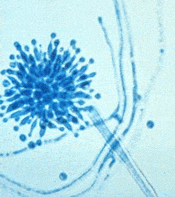Adaptation
Adaptations, which are the products of evolution, can be recognized in all organisms. Being well adapted to the environment increases an organism’s chances of survival thus its ability to reproduce, which is every organisms' goal.
All fungi share the adaptation of having the capacity to secrete
exoenzymes, which are responsible for the digestion of organic
materials outside of the fungal body. (To read more about how
fungi utilize exoenzymes refer to the
nutrition page.) Thanks to exoenzymes, fungi have the
ability to consume a large variety of materials compared to
most other organisms. This also enables fungi to invade
the interior of a substrate.
body. (To read more about how
fungi utilize exoenzymes refer to the
nutrition page.) Thanks to exoenzymes, fungi have the
ability to consume a large variety of materials compared to
most other organisms. This also enables fungi to invade
the interior of a substrate.
Another great adaptation found in fungi is that their cell walls contain chitin for reinforcement and stability. A characteristic that is found among almost all fungi (with the exception of single-celled yeasts) is hyphae. Hyphae are connected filaments that collectively make up the mycelium of a fungus. Hyphae can either be septate or non-septate. Aspergillus flavus is septate meaning the hyphae contain septa which are cross-walls that divide the hyphae into cells. These cross-walls have pores that are large enough to allow ribosomes, mitochondria, and nuclei to flow from cell to cell. Wow, fungi are full of cool adaptations, aren’t they?
One unique adaptation of Aspergillus flavus is the production of mycotoxins. These mycotoxins produced are called aflatoxins; they are not constantly produced but can be triggered to do so by factors including stress. Aflatoxins are highly toxic and carcinogenic. This feature can protect the organism from predators. To find out more about aflatoxin production check out the mycotoxin page!
Let's continue on and take a look at the nutrition of A. flavus.



